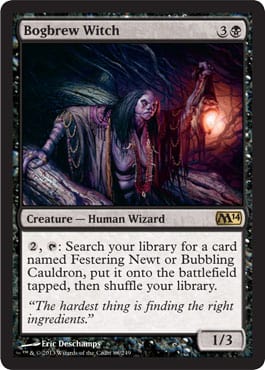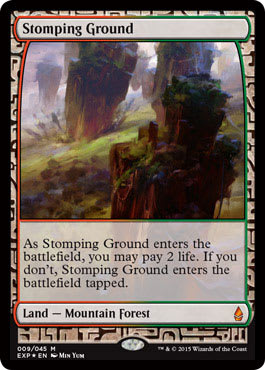Hey there! Last week was a very interesting time for Magic, as both the World Championship and the World Magic Cup took place in Amsterdam. In this article, I will focus on the current Standard environment while also discussing the World Magic Cup. First, I will talk about the event and how we prepared for it, and then I’ll discuss what our ideas were going in to the event. Finally, I will give you some recommendations on what to play in Standard tournaments in the near future.
World Magic Cup
The pool we opened in the Magic 2014 Team Sealed portion was slightly above average in my opinion. We constructed a red and green deck, a white and blue deck and, finally, an almost-mono-black deck splashing red for three Act of Treasons. I was able to play the black deck, and it was super-sweet because it included Bogbrew Witch along with a Bubbling Cauldron and three Festering Newts along with several other good synergies. I thought our decks could easily go 2–1 or maybe even 3–0, but we ended up going a disappointing 1–2 after some close matches. Luckily, we managed to go 3–1 in the first Standard portion to lock up a slot in the Top 32. During the first three rounds of the Standard portion, our matchups were quite good, but in the last round against the Slovak Republic, we had some pretty bad matchups.
The 4–3 result during Day 1 meant we were twenty-fourth going into Day 2, so we were the third seed in our pod. Third seed means that the only record that guarantees you are not eliminated is 3–0, with 2–1 being enough in certain scenarios. We opened what we felt was a very solid pool in the Return to Ravnica block Team Sealed portion, and we thought we had a good shot at making the Top 16. Unfortunately, we ran into a streak of some very bad draws and ended up going 0–3 in matches. A good example of our bad luck was that our A player Sami Haeggkvist cast a total of three spells in the first match. I think we had the better decks in all of our three matches, but the luck just wasn’t on our side this time.
I felt a bit sad to be eliminated at this point in the tournament, as we really wanted to improve on our finish from last year. In retrospect, I would say that the quality of the pool is not as important in this type of team play as compared to, for example, Team Sealed Grand Prix tournaments. As you are only playing three rounds, the variance in the games you play matter much more than the cards you open. I think the opposite is true for longer tournaments—if you have to play eight rounds with the same card pool, the overall quality starts mattering much more.
Standard Business
Now that I covered how the actual tournament went, let’s talk about the Standard portion in a bit more detail. When the formats for the World Magic Cup were announced earlier this spring, I was very excited since Team Unified Standard offers an interesting deck-building puzzle and format to solve. Very early on, I, like many others, realized that lands would be the defining factor in this format. Since the current Standard environment is comprised of mainly two- and three-colored decks, the fact that you are limited by mana bases rather than actual spells is a huge deal. We identified that some of the most important color combinations of lands were R/G, G/W, and W/U. These were the lands that featured in many different archetypes and as such were the most limiting factors.
To prepare for the World Magic Cup, I did a fair bit of theoretical thinking about the format with my teammate Sami Haeggkvist. We agreed that we would most likely want to play Jund, R/W/U, and then a third deck, which would most likely be mono-red or G/W. This seemed to be the best way to feature two of the most powerful decks in the format while still having a solid third deck and not needing to compromise between decks. Before we left for Amsterdam, we did a fair amount of testing with Jund and R/W/U on Magic Online, and when William Jensen made the finals of the StarCityGames Open the weekend before with G/W Elves, it seemed that we had found the perfect third deck. Once in Amsterdam, we started putting G/W Elves through the paces, and it seemed to be a very solid deck. However, Jund was not performing very well, and Sami, who was supposed to play the deck in the tournament, did not feel comfortable with it.
Around this time, the first day of the World Championship was taking place, and we noticed the R/G aggro list Brian Kibler had played in the event. We had previously tested a very similar version of the deck, and it seemed powerful since it had access to Burning Earth, a tremendous card against the decks we were expecting to face. Because the R/G deck then performed so well in testing, we were happy to switch Jund for R/G aggro. The problem now was that we didn’t have a third deck—since the G/W Elves deck needed the same mana creatures that the R/G deck did—leading to some problems. We had not really thought that spells would be a problem since the mana seemed to be the most defining thing about the format.
Due to this clash between decks, we ended up choosing Junk Aristocrat as our third deck even though we were not totally happy with it. During the tournament, the deck felt a bit underpowered, but I still think our deck choices were very good for this tournament. We also decided to put the R/G deck in the middle seat since our reasoning was that the best player on other teams would probably sit in the middle and would probably play R/W/U or Jund. We were expecting most teams to bring R/W/U, Jund, and then a third deck, and the decks we were expecting to be absent from the tournament were Bant Hexproof and Junk Reanimator.
It’s hard to explain since the recent performances have been so good, but I don’t think Jund is a good deck, both for this tournament and in general. The two finalists both had Jund as one deck, and it is certainly capable of solid finishes, but there is just something I don’t like about the deck. One of the factors we figured out was that a lot of the value in the deck comes from 2/2 Wolves and 3/3 Beasts, and if they are not actually doing enough, the whole deck falls apart. As both red and green decks start going bigger with Thundermaw Hellkite and Kalonian Hydra, your tokens don’t really do all that much, which means you need to hit removal spells at exactly the right time or just die. Olivia Voldaren is still very good, as are some of the other cards in the deck, but it just feels that Jund is losing power. A funny anecdote was when we were talking with the Indonesian team before the event. They said they really liked Jund, and we talked about it for a while, and when we saw them the next day, they just said, “Yeah, we switched decks; Jund sucks.”
What to Play?
If you are planning on playing in Grand Prix Warsaw or some other big tournament in the near future, I have a few suggestions for you. The two decks that I feel are very solid and worth playing are R/W/U Flash and Kibler’s R/G aggro. Before the event, I was not overly convinced about R/W/U Flash, but after having played with the deck, I have to say it is very solid and also a deck that rewards tight play. The R/G list played by Kibler is perhaps a bit more forgiving and easier to play, but it is also super-powerful. As I mentioned earlier, Burning Earth is insane against many of the popular decks in the format, and I would really recommend having an answer for it if you plan to play a three-colored deck for yourself.
For reference, here is the R/W/U Flash list I played at the World Magic Cup, followed by the R/G aggro deck we played, only a few cards off from the list Brian Kibler played at the World Championship.
"R/W/U Flash"
- Creatures (11)
- 3 Snapcaster Mage
- 4 Augur of Bolas
- 4 Restoration Angel
- Spells (24)
- 1 Rewind
- 2 Dissipate
- 2 Syncopate
- 2 Turn // Burn
- 2 Warleader's Helix
- 3 Azorius Charm
- 3 Sphinx's Revelation
- 4 Think Twice
- 2 Supreme Verdict
- 3 Pillar of Flame
- Lands (25)
- 1 Island
- 1 Cavern of Souls
- 1 Moorland Haunt
- 3 Clifftop Retreat
- 3 Sacred Foundry
- 4 Glacial Fortress
- 4 Hallowed Fountain
- 4 Steam Vents
- 4 Sulfur Falls
- Sideboard (15)
- 2 Aetherling
- 1 Cavern of Souls
- 2 Dispel
- 1 Negate
- 2 Oblivion Ring
- 1 Supreme Verdict
- 1 Ratchet Bomb
- 1 Warleader's Helix
- 2 Renounce the Guilds
- 2 Izzet Staticaster
I’m not entirely sure whether the Aetherling plan or the Thundermaw Hellkite plan is better, but I do like the power that Cavern of Souls gives you in the control mirrors. I suspect that you will be seeing a lot of R/W/U mirrors in the coming weeks, as the deck performed quite well in Amsterdam. I would also consider adding one Celestial Flare for the Bant Hexproof matchup, as you can also bring it in against decks packing Predator Ooze.
"R/G Aggro"
- Creatures (29)
- 2 Elvish Mystic
- 3 Scavenging Ooze
- 4 Arbor Elf
- 4 Flinthoof Boar
- 4 Ghor-Clan Rampager
- 4 Hellrider
- 4 Strangleroot Geist
- 4 Thundermaw Hellkite
- Planeswalkers (4)
- 4 Domri Rade
- Spells (3)
- 3 Mizzium Mortars
- Lands (24)
- 6 Mountain
- 9 Forest
- 1 Kessig Wolf Run
- 4 Rootbound Crag
- 4 Stomping Ground
- Sideboard (15)
- 2 Bonfire of the Damned
- 4 Burning Earth
- 2 Chandra, Pyromaster
- 2 Flames of the Firebrand
- 1 Pillar of Flame
- 1 Shock
- 1 Volcanic Strength
- 2 Zealous Conscripts
We played the Pillar of Flame and Shock split because the Pillars were already in the R/W/U Flash deck, so you should probably just play the straight two Pillar of Flames.
As always, if you have any ideas, questions, suggestions, or general comments, be sure to contact me either via Twitter or the comments section below.
Thanks for reading,
Max
@thebloom_ on Twitter
Maxx on Magic Online
You can find my music on: http://soundcloud.com/bloomlive


























